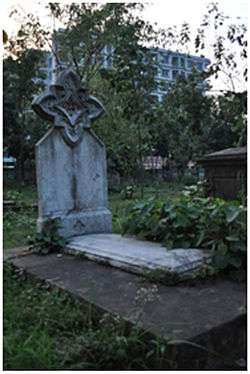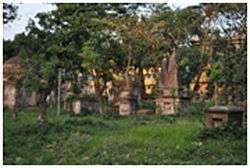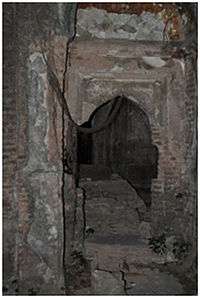Christian cemetery, Dhaka
| Christian cemetery, Dhaka | |
|---|---|
|
Christian cemetery | |
| Basic information | |
| Location |
|
| Geographic coordinates | 23°42′56″N 90°25′11″E / 23.715566°N 90.419783°ECoordinates: 23°42′56″N 90°25′11″E / 23.715566°N 90.419783°E |
| Affiliation | Christianity |
| Architectural description | |
| Architectural style | Christian architecture |
| Date established | 1800 |


The Christian Cemetery is situated at Wari, a district of Old Town in Dhaka. It started to go into a declining state within a few years after it was built, and it still is in ruins and wilderness.
History
It was developed mainly for the European traders and their families, thus most members of the East India Company lie buried there.The oldest grave there belongs to Reverend Joseph Paget, minister of Calcutta, who died there in 1774 at the age of 26.
Present condition
The cemetery had been in a declining state since the early 1800s as noticed by both Reginald Heber, and F.B. Bradley burt, although the decay had a more emotional romantic appeal to him.The original road layout of the cemetery has faded away with time, but it can be understood that a couple of straight roads intersected to make a path system within the network. The tombs were jumbled into a group to form one or two clusters, while making it hardly visible to visitors.
Architectural Significance
The cemetery has six type of tombs in the complex-
Type A- These graves are either really old, and no structure or inscriptions remains; or completely new, such that even the originality of the position of the grave and the inscription can be questioned as the frequent interaction taking place in the monument can be noted to any visitors.
Type B- The Moorish type gateway, which has been severely altered over the years, leads to nowhere. It was placed irrespective of the most imposing monuments of the complex, instead it only provides a plane of entrance towards the empty field in the center. Its position also reveals that no formal layout was maintained.
Type C, D & E- The obelisk and urn resemble the contemporary best known English cemeteries in calcutta; the baroque character of the older and provincial cemeteries. The Indian version of the pyramid stands on a podium where the inscriptions are laid, has a less broad base, which is smoothly uplifted to an acute angled apex.
Type F- The most interesting and striking features of the cemetery complex. The plan varied from round to square to octagonal ones with doric and ionic columns. Among these pavilions the most eye catching and perhaps frequently quoted is Colombo Saheb's tomb. The mausoleum also changed over the years. It contains three graves, surprisingly off-centeredly placed, without any inscription. The panels or the inscriptions were added later, due to the collapse of the original structures due to weathering or other reasons. The lower part of the mausoleum resembles an average mughal mosque, square in plan with four doorways on each side. The front view facade is decorated with three planes comprising a large central face and a lesser one on each side ended up with an octagonal tower at the angles. The central plane is rectangular in shape, the greater part of its surface occupied by a pointed arch and domed recess in the center. Guldastas on wreathed shaft marks the side of the plane. Above the lower mosque-like structure, the builder placed a high octagonal structure with arches on each side and over a baroque style dome together with projected guldastas to replace the traditional chattris.
Notable interments
- Nicholas Pogose (d. 1876) - Armenian merchant and zamindar.[1]
References
- ↑ Haider, M H (11 December 2015). "A TRIBUTE TO COLUMBO SAHIB". The Daily Star. Retrieved 1 September 2016.
| Wikimedia Commons has media related to christian cemetery wari dhaka. |
- Asiatic Society Of Bangladesh. Dhaka( p. 58).
